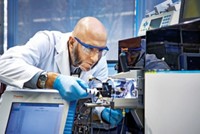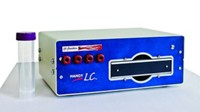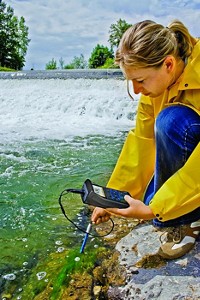Advertisement
Grab your lab coat. Let's get started
Welcome!
Welcome!
Create an account below to get 6 C&EN articles per month, receive newsletters and more - all free.
It seems this is your first time logging in online. Please enter the following information to continue.
As an ACS member you automatically get access to this site. All we need is few more details to create your reading experience.
Not you? Sign in with a different account.
Not you? Sign in with a different account.
ERROR 1
ERROR 1
ERROR 2
ERROR 2
ERROR 2
ERROR 2
ERROR 2
Password and Confirm password must match.
If you have an ACS member number, please enter it here so we can link this account to your membership. (optional)
ERROR 2
ACS values your privacy. By submitting your information, you are gaining access to C&EN and subscribing to our weekly newsletter. We use the information you provide to make your reading experience better, and we will never sell your data to third party members.
Business
Instrumentation The Dionex Way
Even after 35 years, chromatography company stays focused to retain technological edge
by Mitch Jacoby
January 11, 2010
| A version of this story appeared in
Volume 88, Issue 2

In a year that will long be remembered for financial losses, plant closings, wide-scale cutbacks, and layoffs, analytical instrument maker Dionex managed to grow. In its past fiscal year, which ended June 30, 2009, the company reported sales of $385 million, up some 2% from the previous year. That most recent gain extends to 28 years the company’s nearly perfect track record of annual sales growth.
Ask Frank Witney, Dionex’ president and chief executive officer, to share the company’s secret to success and he’ll tell you there is no secret—just a relentless focus. Dionex is a “pure play” chromatography and separations-science company, says Witney, who joined the Sunnyvale, Calif., firm last year. “We’re two inches wide and two miles deep,” he says, meaning the company focuses almost entirely on a few areas in which it has built considerable expertise.
The principal areas are ion chromatography (IC, also known as ion-exchange chromatography), high-performance liquid chromatography (HPLC), and sample preparation. IC equipment and products account for about 65% of company sales. Roughly 28% comes from HPLC products, and the balance is due largely to sample-preparation products.
Analytical scientists working in a broad range of areas use Dionex products. The company’s instruments are found in laboratories specializing in environmental, proteomics, life sciences, and pharmaceutical analyses. They are also widely used in the chemical, food and beverage, power generation, and electronics industries.
Dionex’ tight focus on just a few analytical fields sets it apart from some larger instrument companies. Competitors such as PerkinElmer, Varian, and Thermo Fisher Scientific maintain extensive product lines in multiple areas ranging from chromatography to atomic and molecular spectroscopy to X-ray analysis. Rather than strive to make a presence in all those markets, “our approach is to be best in class in select technologies and instrumentation,” Witney says.
Building cleverly designed lab instruments, however, isn’t enough to guarantee straight A’s in this industry. The keys to achieving top marks, in Witney’s view, are working closely with customers to understand their needs in detail, meeting those needs with top-notch products, and backing those products with excellent service and support.
“Customers don’t buy instruments and components. They buy answers to their analytical problems,” Witney asserts. “We’re not just equipment manufacturers. We’re solutions providers.”
Dionex At A Glance
Headquarters: Sunnyvale, Calif.
Revenues: $385 million
Number of employees: 1,400
R&D spending: $29 million
BUSINESSES (% of total sales)
Ion chromatography (65%): Instruments, columns, detectors, accessories, software
High-performance liquid chromatography (28%): Instruments, columns, detectors, accessories, software
Sample preparation (7%): Instruments for accelerated solvent and solid-phase extractions, accessories
Website: www.dionex.com
That lofty language sounds like a marketing slogan, but longtime customer R. Ryan Williams says it’s really the way Dionex does business. Williams is supervisor of chemical sciences at Chicago-based Celsis, a contract service provider specializing in chemical and microbial analyses. Running down a long list of Dionex IC and HPLC systems his lab uses, he raves about the instruments’ pumping precision, gradient accuracy, sensitivity, and overall performance. But other vendors also make good instruments, Williams acknowledges. So equipment quality isn’t the only draw to Dionex.
“More than anything else, the reason we stay with Dionex is the personal attention,” he states. As a case in point, Williams says he has been “very pleased with the level of help and support” provided by Dionex to configure Chromeleon, a Dionex data acquisition and management software package, to run all of his lab’s chromatography equipment—not just the Dionex units.
Similarly, Celsis uses Dionex’ new IC system and electrochemical detector in novel applications and to run recently developed analytical methods, for example in carbohydrate and heparin analysis. These instruments are versatile and can be configured and used in many ways. “The Dionex team has worked closely with us to help set up and run the instruments in the best way to get us the results we need,” he says.
In the 35 years Dionex has been a company (it went public in 1982), ion chromatography has been its biggest business, accounting for up to two-thirds of sales in recent years. Unlike conventional chromatography, which separates neutral species, IC separates mixtures of cations and anions on the basis of charge. In IC, analytes are distinguished according to how strongly they cling by electrostatic interaction to an ion-exchange resin in the chromatography column. Some of the key developments in ion-exchange technology were made in the early 1970s at Dow Chemical. A subsequent licensing agreement led to the formation of Dionex, which gets its name from Dow Ion Exchange.
“We have patented technology surrounding ion chromatography that has given us a strong advantage in this area,” says Craig A. McCollam, Dionex’ chief financial officer. Coupled with a drive to constantly improve its products, that technological advantage has enabled Dionex to dominate the field as the number one IC company for years. According to McCollam, the company leads the field with a 70%-plus share of the roughly $325 million worldwide IC market. The Swiss firm Metrohm holds around 15% of the market, and the rest is fragmented, he says.
In the mid-1990s, Dionex expanded beyond IC by offering automated sample-preparation equipment. These instruments were designed to overcome the sample-extraction bottleneck common in analysis of food, soil, and other matrices, and they now account for about 7% of sales.
In conventional methods, extraction involves treating samples with solvents under conditions of standard temperature and pressure to obtain analytes for subsequent identification via chromatography or other methods. Raising the temperature and pressure increases analytes’ diffusion rates and solubilities, which in turn speeds up extraction.
Dionex’ accelerated solvent extraction (ASE) instruments exploit that process improvement and do so in an automated fashion (C&EN Online, March 30, 2009). For example, conventional sample preparation for typical pesticide-residue analyses of fruits and vegetables can take several hours and consume hundreds of milliliters of solvents. By using ASE instrumentation at 200 °C and 1,500 psi, researchers can reduce preparation to roughly 15 minutes with 15 mL of solvent.
Dionex entered the HPLC market in full force about a decade ago with the acquisition of Softron, a chromatography company based in Germering, Germany, near Munich. Development of HPLC products and software continues there today. Competition in this market, which is estimated at $2 billion worldwide, is intense, yet newcomer Dionex is making a strong showing.
In fiscal 2009, Dionex’ sales of HPLC systems, columns, detectors, and related products reached roughly $120 million, according to Dietrich Hauffe, vice president for corporate marketing. The HPLC market as a whole shrank by 3–5% in the past three quarters, he says. Yet during that period, Dionex’ HPLC-related sales continued to increase, he points out, putting it in roughly fourth place behind market leaders Waters, Agilent, and Shimadzu.
No single factor explains how Dionex has managed to increase sales every year since 1982 except in 2002, when revenue dipped about 2%. A strong international base certainly plays a role. This past year, when the recession pushed down sales by a few percent in North America and Europe, which account for roughly 30% and 40% of sales, respectively, Dionex grew by about 18% in Asia, notably in China, Taiwan, and India.
In addition, the company’s strong commitment to research and product development—supported to the tune of $25 million to $30 million during each of the past three fiscal years—results in industry-recognized technological advances. For example, R&D Magazine recently selected Dionex’ reagent-free IC technology as an R&D 100 Award winner for 2009. The technology enables laboratories to continuously perform analyses—of drinking water, for example—for about a month without the need to replace the eluent with a fresh batch.
It’s not just cutting-edge technology that industry watchers recognize. Richard C. Eastman, a stock analyst with Milwaukee-based investment firm Robert W. Baird, is impressed with Dionex’ business strengths. Dionex has a good position in the liquid chromatography marketplace and a solid installed base of customers, Eastman says. That base goes hand-in-hand with a high percentage of sales of columns, instrument parts, and other consumables, which are good profit drivers, he points out.
Competitors follow the industry trend of building broad portfolios that include many types of analytical instruments. That approach may appeal to customers who want a vendor that can supply complete analytical systems from start to finish, Eastman says. In contrast, Dionex’ strength is its focus on liquid chromatography. The Dionex brand is well recognized, and the company is known for its chemistry competency and applications knowledge, Eastman says. “That’s key from a customer perspective.”
Witney expects the financial challenges of 2009 to continue through the first half of 2010 but isn’t planning radical changes. “Our job is to continue making our customers more competitive in their jobs,” he says. “We plan to do that by remaining focused and innovative and staying on the leading edge of the curve.”





Join the conversation
Contact the reporter
Submit a Letter to the Editor for publication
Engage with us on Twitter